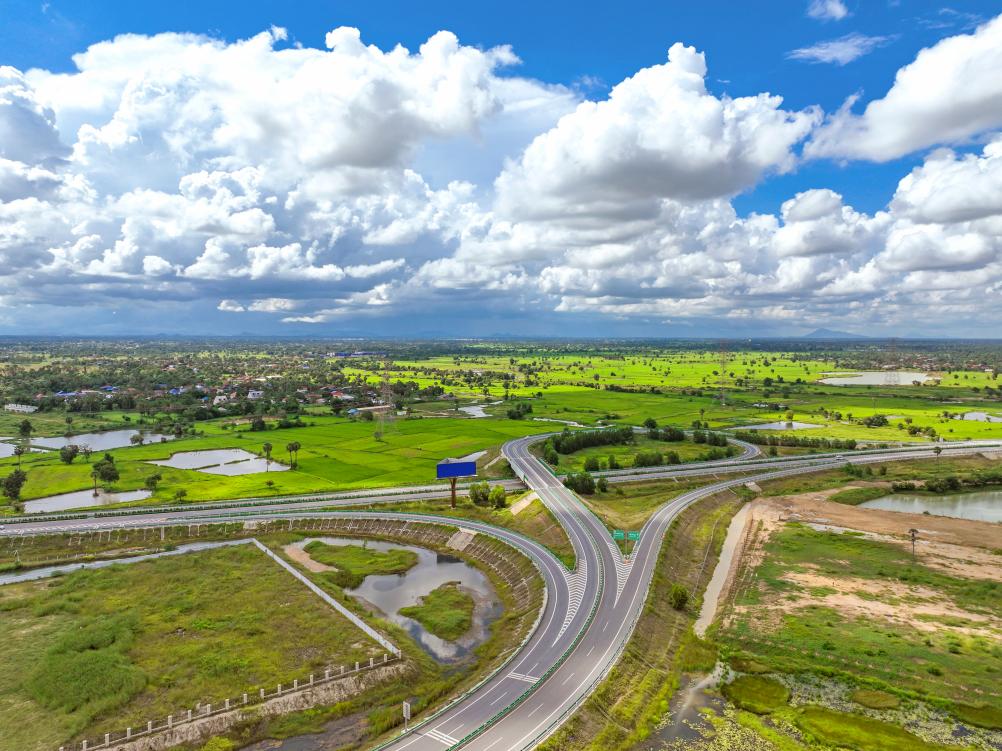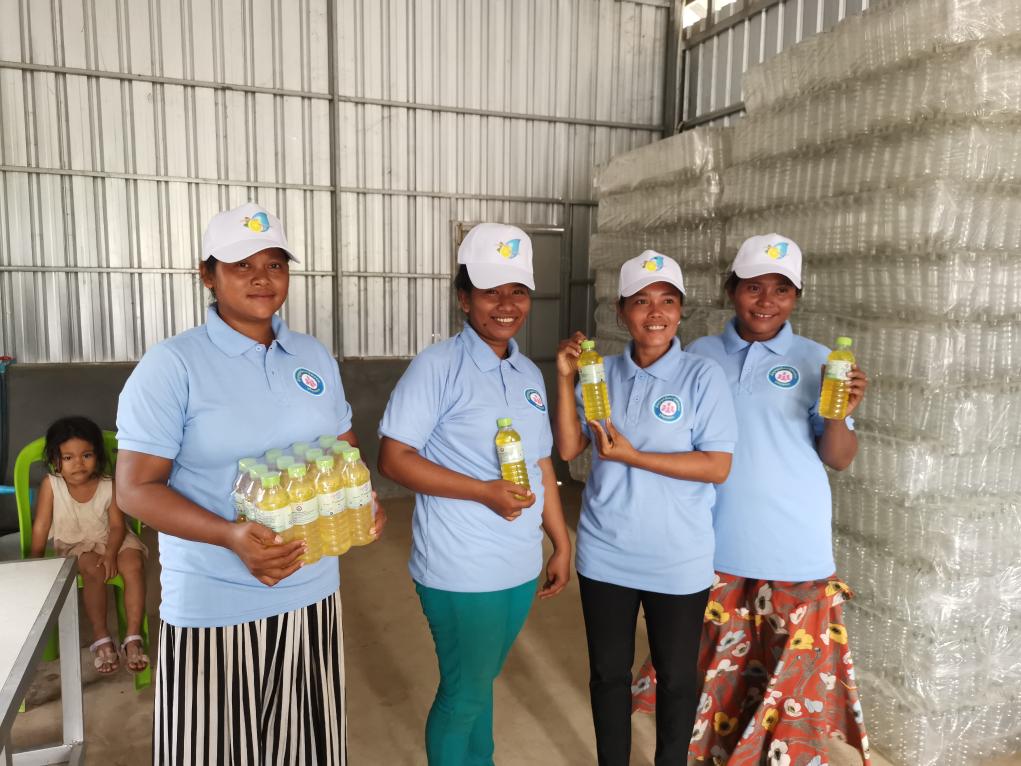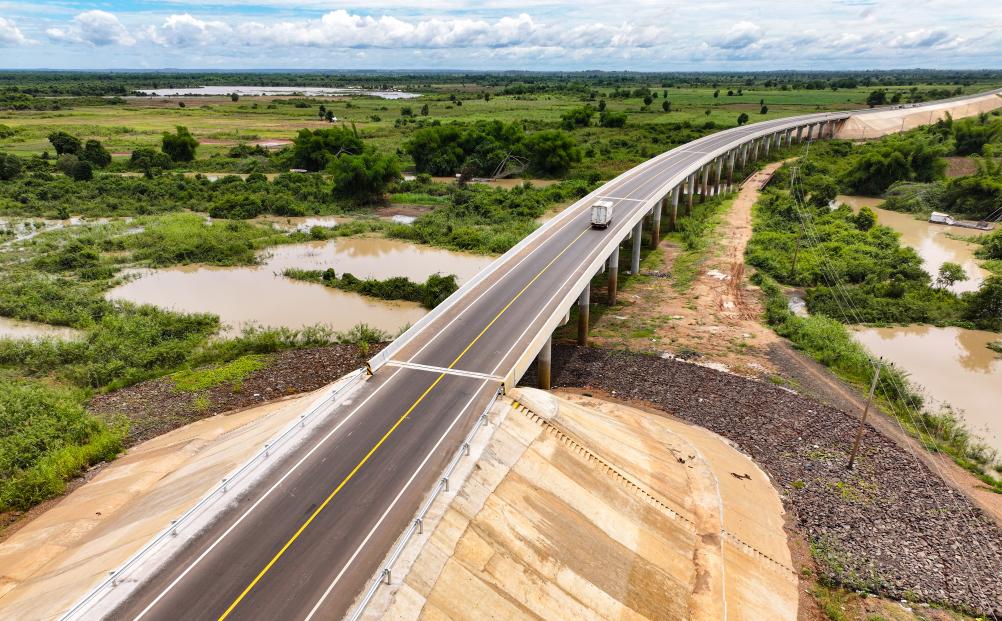Make friends with villagers from impoverished villages and carefully inquire about their needs; Roll up your pants and stand in the pond, teaching the villagers how to lay shrimp fry; In the eyes of many Cambodians, the Chinese friends’ actions in the local area are “heartwarming, concrete, simple, and pragmatic” by turning the dirt roads that are submerged during the rainy season into wide roads. And it is precisely the fruits of these little things that are gradually changing their lives.
In the view of Xie Monile, President of the Cambodia China Relations Development Association, as a “loyal friend” of Cambodia, China is sharing its development experience with Cambodia through specific projects, which has become a vivid portrayal of the two countries working together to build a new era of China Cambodia community with a shared future.
 This is a drone photo taken on September 25, 2024, on the Jin Gang Expressway in Kampong Speu Province, Cambodia. Shen Jizhong
This is a drone photo taken on September 25, 2024, on the Jin Gang Expressway in Kampong Speu Province, Cambodia. Shen Jizhong
Pay attention to China’s development experience
Xie Monile said that in his lecture, Cambodian officials generally focused on China’s experience in poverty alleviation. He has repeatedly used his participation in the China Cambodia Friendship Poverty Alleviation Demonstration Village Project as a case study to explain. What impressed him the most was that the Chinese poverty alleviation team went into the homes of villagers, conducted detailed research, asked about their needs, and then guided them in raising chickens, cows, and vegetables according to the actual situation of each household.
 On July 31, 2020, villagers showcased the production of dishwashing detergent at a dishwashing detergent processing plant in Swaanpu Township, Momukamp County, Kandal Province, Cambodia. The demonstration cooperation project of China’s aid to Cambodia for poverty reduction has promoted the sustainable development of two poverty-stricken villages here, radiating new vitality. Shen Jizhong
On July 31, 2020, villagers showcased the production of dishwashing detergent at a dishwashing detergent processing plant in Swaanpu Township, Momukamp County, Kandal Province, Cambodia. The demonstration cooperation project of China’s aid to Cambodia for poverty reduction has promoted the sustainable development of two poverty-stricken villages here, radiating new vitality. Shen Jizhong
Teach people how to fish according to local conditions
The Mekong River meanders and flows through numerous lakes, ponds, and wetlands, providing excellent conditions for rice cultivation and fishing. Many regions in Cambodia are truly “land of fish and rice”.
Since 2021, Professor Wu Xugan from the School of Fisheries and Life Sciences at Shanghai Ocean University has visited Cambodia’s Chajiao Province multiple times to train farmers in raising Macrobrachium rosenbergii in local villages. The local fishing industry is relatively extensive. Some people make a living by catching wild fish, while others raise rice fish. However, the fish fry are wild fish fry brought in during the rainy season floods, and they basically rely on the weather to make a living.
Based on the local warm climate conditions, Wu Xugan chose to teach farmers rice and shrimp farming techniques, starting from how to clear ponds and teach shrimp seedlings, truly achieving the goal of “teaching people how to fish”. Several demonstration households were able to generate $3000 in revenue from each shrimp pond during the breeding season from September last year to January this year. A large and creamy Roche swamp shrimp was sold to nearby tourist restaurants and became a signature dish.
Vilabohu, a Cambodian international student majoring in aquaculture at Shanghai Ocean University, participated in this project. He said that many farmers in the surrounding area initially insisted on using soil methods to raise rice and fish, but after seeing the actual results, they took the initiative to come and learn. Training one demonstration household can drive 10 surrounding farmers
In recent years, demonstration bases for various crops such as rubber, coconut, and pepper have been established through cooperation between China and Cambodia, helping to increase production and efficiency in local agriculture; The Chinese side held a training course on standardized banana production technology to impart experience in the industrialization of fruit cultivation; The completion of the Cambodian Precious Tree Species Breeding Center in cooperation between the two parties promotes sustainable forestry development… In the “Fish and Rice Corridor” cooperation, more and more Chinese teams and technicians are appearing, injecting momentum into local agricultural and rural development.
The Chinese team knows how to implement policies based on local conditions, “said Tessomoni, the director of the Cambodian Ministry of Agriculture, Forestry and Fisheries in charge of aquaculture development.” China has helped Cambodia expand the long-term development path of agriculture and helped the agricultural communities in the entire region build a more resilient and sustainable future.
China’s development never stops at slogans, “said Song Du, the director of the Royal Academy of Cambodia, who has visited China multiple times to learn from the experience of precision poverty alleviation and rural revitalization. What impressed him the most was that Chinese farmers planted tea trees on slopes that were not suitable for growing crops. Cambodia should learn from China’s development philosophy of starting from reality and adapting to local conditions
Where there is a way, there is hope
On April 12th, thousands of Cambodian citizens held the flags of Cambodia and China and arrived early in Stentrang County to witness the official opening of Cambodia’s National Highway 71C.
This national highway, constructed by a Chinese enterprise, is flat and open, connecting the provinces of Kampong Cham and Tebunkmon on both sides of the Mekong River through a bridge, linking multiple provincial and rural roads.
Many sections of this road were previously dirt roads, which would be submerged during the rainy season and require rowing to pass through. Danxin, a 51 year old resident of Kampong Cham province, told reporters that the road has greatly facilitated transportation between the two provinces, making it easier for farmers to transport locally produced cassava starch, cashews, and rubber.
 This is a drone photo taken of National Highway 71C in the province of T é b é nkment, Cambodia. The opening ceremony of Cambodia’s 71C National Highway, constructed by Shanghai Construction Engineering Group Co., Ltd., was held on April 12th in T é b é nkment, Cambodia. Xinhua News Agency (Photo by Nidora)
This is a drone photo taken of National Highway 71C in the province of T é b é nkment, Cambodia. The opening ceremony of Cambodia’s 71C National Highway, constructed by Shanghai Construction Engineering Group Co., Ltd., was held on April 12th in T é b é nkment, Cambodia. Xinhua News Agency (Photo by Nidora)
The Chinese often say, “If you want to be rich, build roads first.” The Cambodian proverb says, “Where there is a road, there is hope.” Danxin told reporters that the people of both countries know that the road will “attract popularity and wealth”.
In recent years, the story of “road” between China and Cambodia has been constantly expanding: the first highway in Cambodia, the Jingang Expressway, built by Chinese enterprises, has been in operation for more than two years. The village of Wosa along the highway has signed construction contracts with three clothing factories through investment promotion; Danong Village, a demonstration village for poverty alleviation through friendly cooperation between China and Cambodia, has a smooth cement road, and villager Bosojin has opened a grocery store on the roadside; Thanks to the “information highway” built by Chinese enterprises, food delivery applications, online shopping platforms, and ride hailing apps have become popular in major cities in Cambodia… Road has brought hard and soft connectivity, further enhancing the emotional connection between the Chinese and Cambodian people.
 This is the under construction Dechong International Airport captured on March 6, 2025 in Kandal Province, Cambodia. Xinhua News Agency (photo by Wanpo)
This is the under construction Dechong International Airport captured on March 6, 2025 in Kandal Province, Cambodia. Xinhua News Agency (photo by Wanpo)
Hong Songning, Deputy Secretary General of the General Secretariat of the Development Council of Cambodia, stated that connectivity will promote the flow of economic factors, bring development and prosperity, especially in the field of infrastructure. China’s investment has enhanced the confidence of local people and made them feel more hopeful about their lives.
Hong Songning said that China has played a crucial role in Cambodia’s development process, from having no roads in the past to now having smooth and unobstructed roads.
On the path of promoting common development and working together towards rejuvenation, China and Cambodia, as good neighbors, friends, and partners, are moving forward hand in hand.
